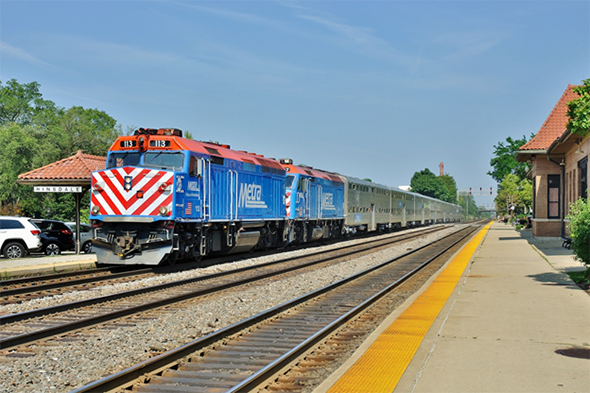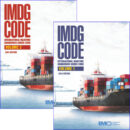
The FRA released 25 million additional dollars in federal grant money to assist local communities to enhance grade crossing safety. Here, a Chicago Metra commuter train speeds over a busy road crossing in west suburban Hinsdale, Illinois on a sunny afternoon in August of 2014. Image © 8/2014 by Nikki Burgess; all rights reserved.
Together we marked the somber fifteenth anniversary of the September 11th attacks in the week just concluded. I hope that everyone had an opportunity to consider the impact to our nation of so terrible an event, and what it has meant to us as we have moved forward in to too often troubled times. Let us hope never to face such awful moments again, and especially, let us take time to thank all of the people who sacrificed on that terrible day, and those who have continued to do so, including up to the present moment.
In the meantime, even as the summer of 2016 begins to recede into the hazy past, the burgeoning fall weather nationwide sees the regulatory beat continue with the following news and events:
PHMSA
- PHMSA finally published the previously discussed (see the previous DG Digest) international harmonization NPRM. To re-review its high points, we offer the following verbatim summary provided courtesy of the Council on the Safe Transportation of Hazardous Articles (COSTHA):
- Updated Hazardous Materials Table (HMT)– PHMSA is proposing a number of modifications to entries and new entries in the Table.
- Polymerizing Substances – Four (4) new entries are being added to the HMT as well as defining criteria, authorized packagings, stabilization methods, and operational controls. These provisions have already been adopted into the 19th UN Model Regulations.
- Modification to the Marine Pollutant List – PHMSA is proposing to revise a number of MP entries based on changes to the IMDG Code and further evaluation of currently included materials.
- Packaging for Water-Reactive Materials By Vessel – The International Maritime Organization (IMO) recently adopted revisions to packaging and packing instructions to improve packaging for water-reactive materials when shipped by vessel. PHMSA is proposing to require hermetically sealed packaging in some cases, and sift-proof and water resistant packaging or liners in others.
- Lithium Battery Hazard Communication – PHMSA is proposing to adopt the new lithium battery label (Class 9) and the new lithium battery mark (for small batteries). Further, as the new mark will provide clear guidance as to what is contained in the package, PHMSA is also proposing to eliminate the documentation requirement for small battery shipments. However, they are also limiting the marking exception for batteries contained in equipment when more than two packages are contained in a consignment.
- Engine, Internal Combustion/Machinery, Internal Combustion – Consistent with the UN Model Regulations, PHMSA is proposing to separate Engines, Internal Combustion/Machinery, Internal Combustion into new entries and UN numbers (UN3528-UN3530). The exceptions for engines will remain (engines and machinery which do not contain any flammable liquid, gas, or any material subject to the HMR will not be regulated under the entry). However, they are proposing to adopt transportation requirements for engines and machinery when shipped by vessel. These include different levels of hazard communication depending on quantity and type of fuel and fuel tank capacity.
- US-Canada Regulatory Cooperation Council (RCC) Proposals – The efforts of the RCC are resulting in a number of proposals in the NPRM. They include:
- Recognition of TC Cylinders
- Recognition of Equivalency Certificates
- Recognition of Inspection and Repair of Cargo Tanks
Here again is a link to the proposal
- Interested in engaging with the COSTHA, a leading industry association representative to PHMSA and other relevant bodies? See their website at www.costha.org for further information.
EU Chemicals
The European Chemical Agency (ECA) has released a completely updated guide to the handling and classification of chemicals under its CLP laws (the approximate analog of the US’s OSHA Hazard Communication Standard). Important news for shippers to Europe! See the updated set of documents here
Ocean News
The People’s Republic of China (PRC) updated its ongoing decontamination requirements for shipping containers going to that nation, to address the current problem with the mosquito-borne Zika virus. China had been requiring that all containers from the US be so treated; that requirement has been relaxed to include only those originating in Florida. See more here
FMCSA
- In a move sure to create strong interest in the motor trucking industry, the FMCSA published a proposed rule that if adopted will require the installation of mandatory speed limiting devices (commonly called governors) in all vehicles over 26,000 pounds Gross Vehicle Weight Rating (GVWR). While such devices are usually offered as options on current vehicles, this is the first time that such installations would be mandated. The governing speed was not stated in the NPRM; instead, FMCSA indicated that they were considering a range of speeds from approximately 60 to 75 MPH, with 68 MPH seeming to be the most likely compromise candidate spped. See more here
- This is also FMCSA “Brake Safety Week” when that agency partners with state and local law and compliance enforcement to help check out the nation’s truck fleet for safer brake systems. Drivers will want to make extra sure that their onboard systems are in top shape in case they become subject to checks. Find out more here
- FMCSA also published a notice seeking additional comments on its plan to revise the way it regulates drivers in commercial service who may be afflicted with Diabetes Mellitus. This topic is more controversial than it may sound at first glance, and has generated considerable commentary from the public; FMCSA wants more. See the latest and state your case here
OSHA
- OSHA is proposing to revise and tighten its regulations regarding fall protection and other safety standards in the maritime industry, specifically ship construction, repair, and demolition. The standards in place now have not been updated since 1971. Find out more about the proposed revision here
- OSHA also pulbished an information collection request (ICR) that will revise the way it seeks information from employers about recording employee illnesses and injuries. The revision is expected to decrease the time private companies have to spend working with such data. See the proposal here
EPA News
The US Environmental Protection Agency published a list of graduates from its new “Environmental Justice Academy” or as the agency terms it, the “EJA.” The EJA training program is primarily based on EPA’s Collaborative Problem-Solving (CPS) Model, a seven-step process for bringing about positive change and community revitalization by having community leaders, community members, and their stakeholders working together. Each module focuses on one element of the CPS Model and includes a combination of lectures by subject-matter experts, in-class exercises, and homework assignments. Interestingly, the agency is administrating this program via its Region 4 Facebook social media page, vice its traditional website. Here’s the link
FRA
The Federal Railroad Administration continued its program of grants to communities in reference to railroad crossing safety. The latest release was over twenty-five million dollars. If you are interested in seeing if your community could benefit from participation in this program, see more information here
Samsung Galaxy Note & Mobile Device Recall
At this point given the widespread reporting in the press, it seems unlikely that anyone affected has failed to already hear about the recall associated with the Samsung Galaxy Note 7 mobile device. The Lithium batteries in the now somewhat infamous units are alleged to be the culprit in several incidents of fires and or explosions allegedly related to operating or charging the devices. Here is a compilation of the various warnings and notices associated with the recall from the most relevant agencies:
Labelmaster is a full service provider of products and services for the Hazardous Materials and Dangerous Goods professional, shippers, transport operators, and EH&S providers. See our full line of solutions at www.labelmaster.com.


